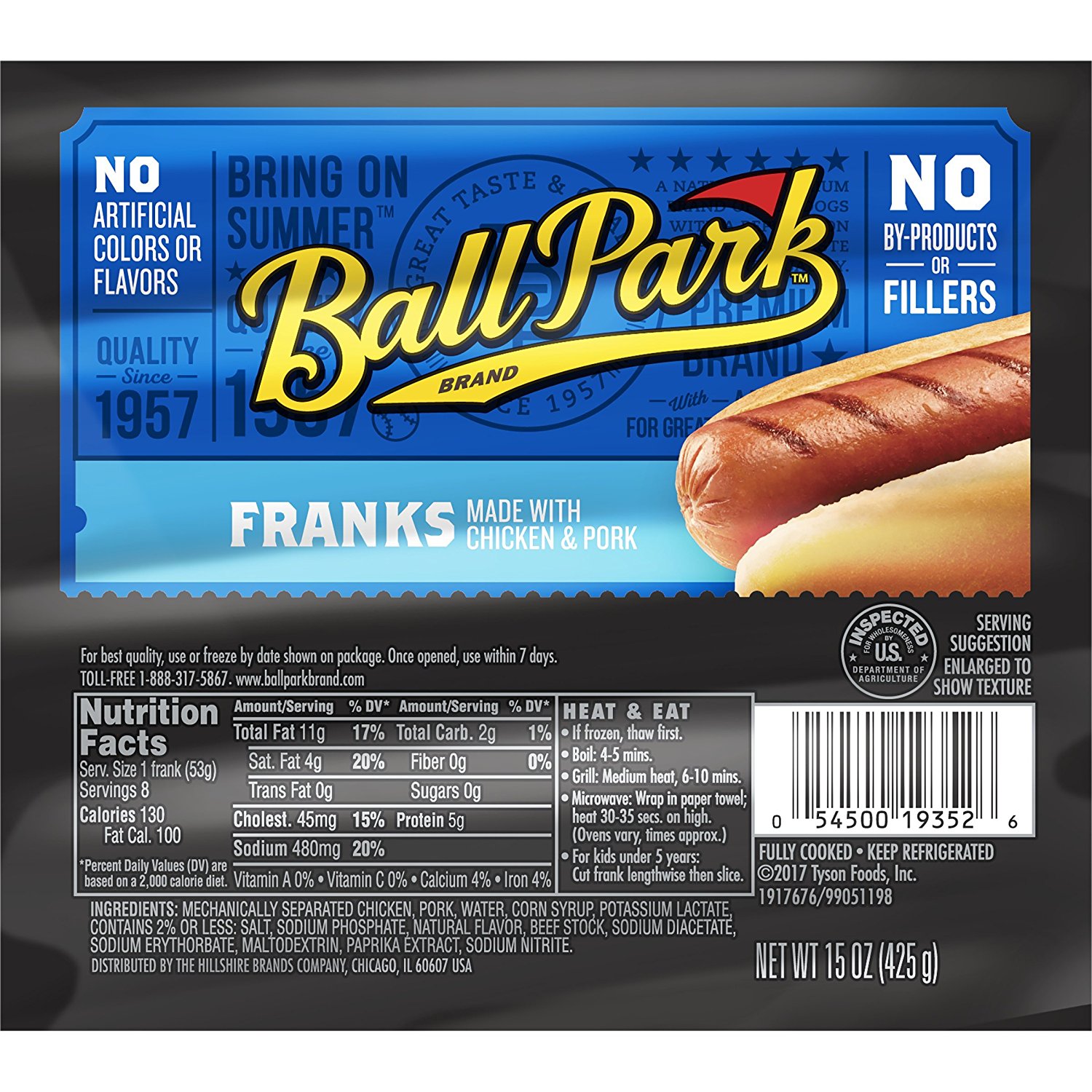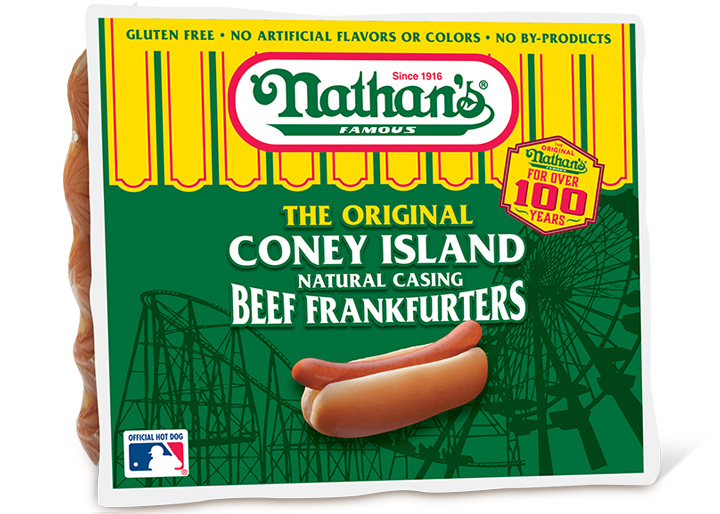How Ballpark Beef Hotdogs Are Made the Real Story
Hot dogs are a quintessential summertime barbecue staple, but oftentimes, the ingredients are far from what we'd deem necessary. From all the tall tales y'all've heard almost franks — enter: pink slime and rodent remains — wouldn't you like to know what's actually in that wiener before you lot hitting upwardly your next cookout or beachside BBQ?
We decided to take a peek at the ingredient lists of ii popular hot dog brands: Ball Park and Nathans. Then, we enlisted the help of certified health and wellness coach and integrative nutritionist Molly Hoffman to go through each ingredient listed to review what information technology actually is as well as what effect it may have on your body.
Find out what these questionable terms really mean below. And just so you know, we're in no way trying to deter y'all from enjoying this grilling staple. Just club one of the healthiest hot dogs (listed at the end of this article), and jushe it up with these 16 Delicious Ways to Dress Your Hot Dog Beyond Ketchup and Mustard.
Ball Park's Classic Hot Dogs
Take a look at the ingredient list of Ball Park's Classic Hot Dogs: Mechanically Separated Chicken, Pork, H2o, Corn Syrup, Potassium Lactate, Contains two% Or Less: Common salt, Sodium Phosphate, Natural Flavor, Beefiness Stock, Sodium Diacetate, Sodium Erythorbate, Maltodextrin, Paprika Extract, Sodium Nitrite.
Now, let'due south dive into each of these to explain what they are, why they're in your hot canis familiaris, and what they can do to your torso.
STAY INFORMED: Sign upwards for our newsletter to get the latest food news delivered direct to your inbox.
Mechanically Separated Craven
According to the USDA, mechanically separated chicken "is a paste-similar and batter-like poultry product produced by forcing basic with attached edible tissue through a sieve or similar device under high pressure to carve up bone from the edible tissue." Mechanically separated poultry has been used in poultry products since 1969.
What makes mechanically separated chicken different than the legs and thighs you lot covet at barbecues? Well, information technology comes from the same animal, but it'due south the waste you typically set out for the garbage truck. Run into, in the '60s, someone in the meat manufacture began to question whether in that location was any utilize for the fibrous pieces of meat left clinging to carcasses after the recognizable cuts had been removed. To answer the question, processors began siphoning animal remains — bones and all — through pressurized sieves that extracted all the edible pieces and churned them into a bright pink paste, co-ordinate to the USDA. The goal was to wring every terminal dollar out of every final carcass, and a British main trading standards officer estimated the cuts to be ten times cheaper than traditional cuts. Today, mechanical separation is commonplace, and the extracted sludge is typically pressed into hot dogs, jerky sticks, and other candy deli meats.
Potassium Lactate
Because it inhibits mold and fungus growth, potassium lactate is a commonly-used preservative in hot dogs and deli meats. Yous might meet sodium lactate on other frankfurters' ingredient lists, as well. That's a type of salt "added to food to extend shelf life and inhibit the growth of pathogens in meat," Hoffman says.
Natural Flavor
"Don't be fooled by the word 'natural' as these flavors may be extracted via toxic chemicals that are not present on the food characterization," Hoffman says.
Sodium Diacetate
Sodium diacetate battles the pathogens introduced by unscrupulous farming practices. In April 2011, researchers in Arizona tested meat and poultry samples from 5 major United states cities and discovered that 47 pct were contaminated with Staphylococcus aureus, the bacterial strain responsible for virtually staph infections. Worse notwithstanding, more than half were resistant to at to the lowest degree three classes of antibiotics. Where did these drug-resistant superbugs come from? It's suspected that by constantly pumping farm animals full of bacteria-fighting drugs to promote growth, nutrient producers have encouraged the growth of stronger bacterial strains.
According to the FDA, 80 percent of the antibiotics sold in the Usa are used on animals, non people, and that'southward why we need additives like sodium diacetate: to protect us from our own food organization. (Information technology'south enough to make you want to stock your kitchen with meat-costless proteins.) And the sodium erythorbate on the ingredients list? That's "a preservative usually added to meat to maintain aesthetics," Hoffman adds.
Sodium Nitrite
The most controversial additive on this ingredient list, nitrites and nitrates are unsettlingly common in the deli libation, and they play roles in curing and preserving the pinkish color of meats and fish. "Sodium nitrate is a nutrient preservative used to maintain artificial flavors, create appealing colors, and add season to processed meats like hot dogs. The Globe Health Arrangement (WHO) has declared Sodium nitrate as a 'probable' carcinogen," Hoffman says. Trouble is, in one case ingested, nitrites can bond with amines to grade cancer-causing nitrosamines.
Fat
You might think that all the poultry beingness pumped into hot dogs has made them leaner over the years, only the numbers don't lie. According to the USDA, in 1937 the boilerplate hot dog was composed of 19 per centum fat and 19.6 pct poly peptide. The humble frankfurter has plumped upward quite a flake in the terminal 75 years; today, hot dogs contain about 28 pct fat to only eleven.7 percent poly peptide. Brawl Park, one of America's iconic dogs, fares even worse.
Nathan'due south Original Beef Frankfurters

As for other hot dog brands, such equally Nathan'southward: "Although the kickoff ingredient in Nathan's hot dogs is highly recognizable 'Beef,' y'all should consider where the meat came from. It is highly likely that the not-organic beef hot dogs are produced from low-quality scraps with an abundance of added hormones," Hoffman warns. Nathan's Original Beef Frankfurters may have "Natural" plastered on their labels, yet they're annihilation but. If you plan to pick up a pack of these dogs before grilling, you'll some other sketchy ingredients on its list. Take a expect:
Beefiness, Water, Contains two% or less of Salt, Sorbitol, Sodium Lactate, Natural Flavoring, Sodium Phosphate, Hydrolyzed Corn Protein, Paprika, Sodium Diacetate, Sodium Erythorbate, Sodium Nitrite
Sorbitol
"Sorbitol is a highly processed carbohydrate alcohol that can cause digestive distress similar gas and bloat. Definitely not something you want to take at a pool political party!" Hoffman states.
Sodium Phosphate
"Sodium Phosphate is a nutrient additive used to keep processed meats moist. Historically it was used as a handling for constipation as information technology can cause breadbasket upset. Additionally, too much of this additive can cause an imbalance of minerals in the body like calcium, and eventually cause osteoporosis."
Hydrolyzed Corn Poly peptide
"Hydrolyzed Corn Poly peptide is a flavor enhancer that contains glutamic acid. Many are familiar with the sodium table salt version of glutamic acid called MSG which tin cause migraines, heart palpitations, shortness of jiff, increased risk of obesity and increased LDL cholesterol (simply to proper noun a few!)," Hoffman says.
What hot dogs to purchase
In its best, most unadulterated form, a hot dog can nonetheless be a solid meal choice, merely you must choose wisely.
For your dollar, Applegate Natural Beefiness Hot Dogs, Teton Waters Ranch's Uncured Beefiness Hot Dogs, Fork In The Route Foods Honest Dogs, and Organic Valley Uncured Organic 100% Grass-fed Beefiness Hot Dogs are four of the all-time hot dogs for weight loss considering they're made from grass-fed beef and spices. For more than clean, unmysterious meats to throw on the grill, check out these 29 Best-Always Proteins for Weight Loss.
Source: https://www.eatthis.com/whats-really-in-your-hot-dog/
Post a Comment for "How Ballpark Beef Hotdogs Are Made the Real Story"